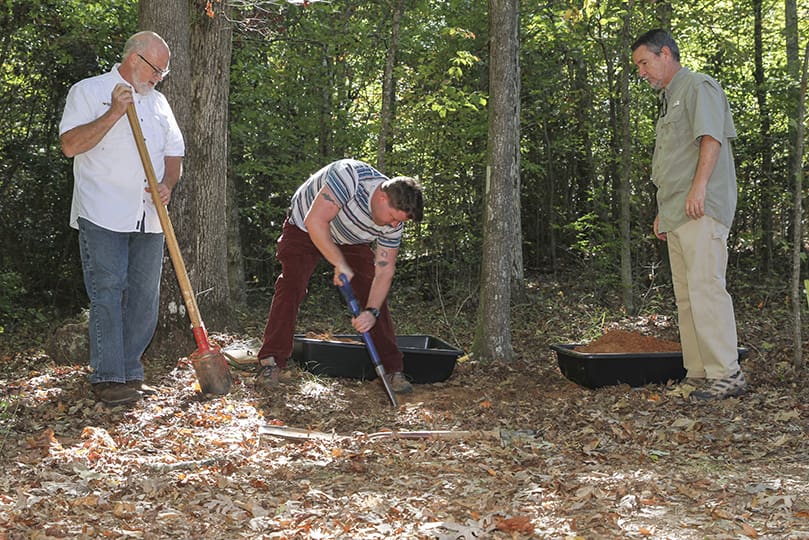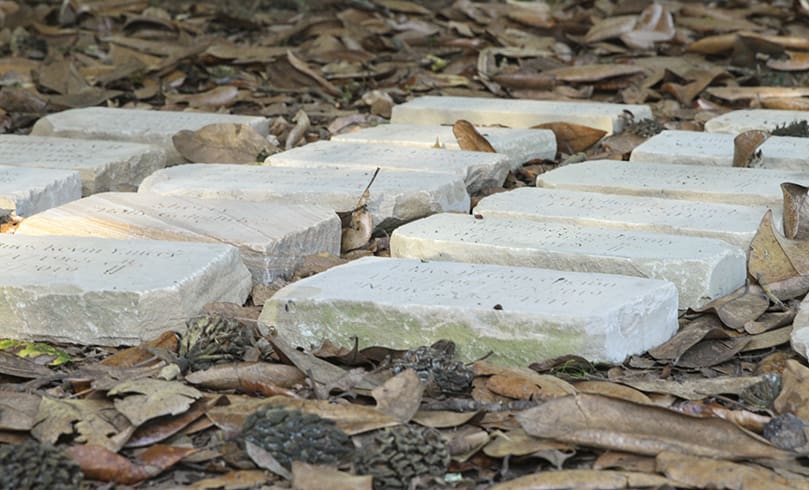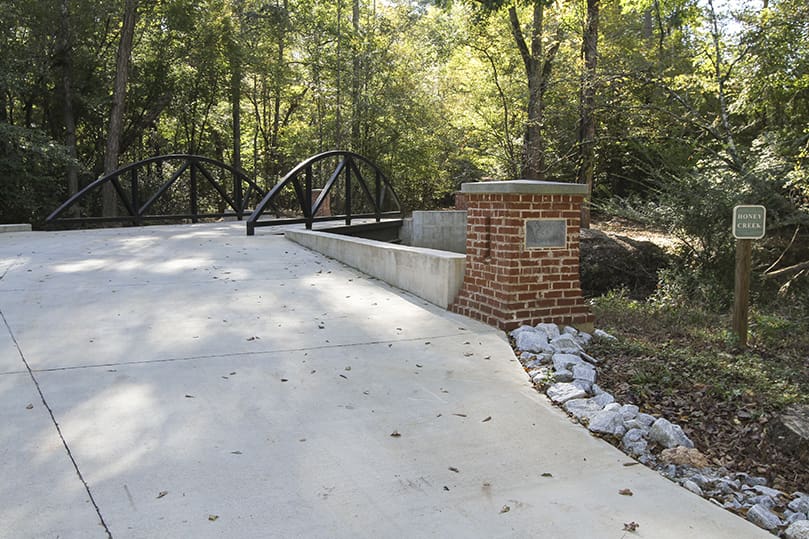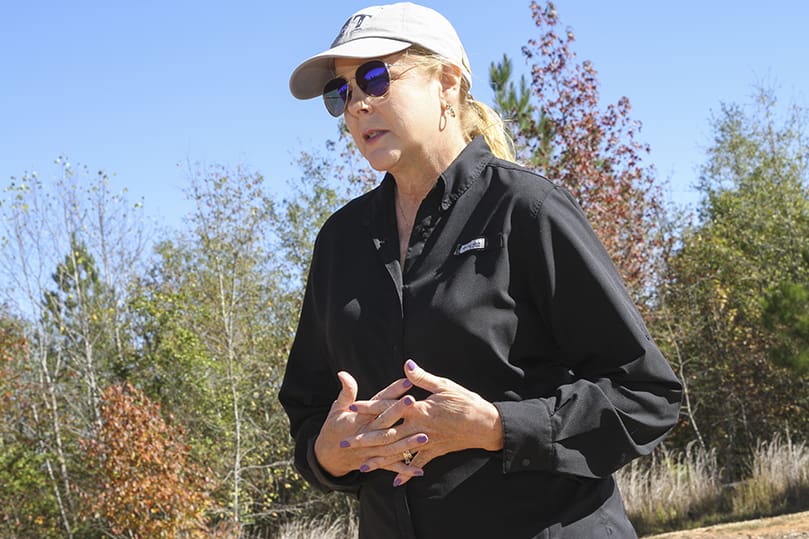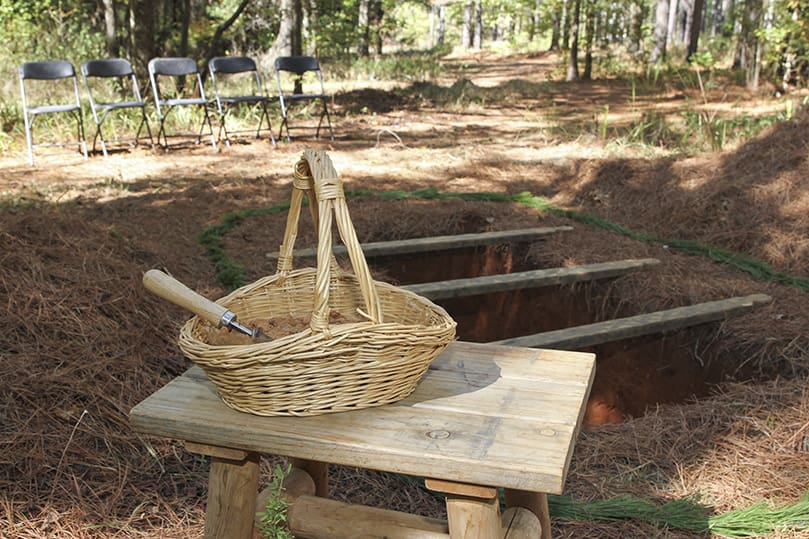(L-r) Michael Wojcik, steward at Honey Creek Woodlands, Conyers, and Jeff Brennan take turns digging a hole for an upcoming double cremation service. Looking on from the right is retired manager and burial marker engraver, Joe Whittaker. Photo By Michael Alexander
Conyers
Bound by shared grief, staff assists families at natural burial grounds
By ANDREW NELSON, Staff Writer | Published November 14, 2019
CONYERS—There’s the father who regularly visits his buried son with a bag of doughnuts for the staff.
There’s the request by a mother for Honey Creek Woodlands staff to tell her buried child “she still loves him” when they pass his final resting place.
Staff at this natural cemetery know what it means when heartfelt requests come from grieving families. Three of the staff members themselves have family buried among the pines and the grasslands.
“There’s something that happens here and it’s very transformative,” said Elaine Bishoff, who buried her father here.
“People come here, sometimes it happens when we’re looking at sites like it did with my own family and sometimes that happens with the service where they’re bracing and they’re nervous and they’re grieving, it lifts. All of a sudden they’re smiling and they’re relaxed and they start talking like, you know, like they’re just talking with their family,” she said.
November is a month believers remember and pray for their beloved dead. The month starts with All Saints’ Day, followed by All Souls’ Day.
Honey Creek Woodlands in Conyers is a burial ground for those who wish to be buried in the simplicity of a wooden box or a shroud. Graves are marked with discreet sandstone markers. The acres are owned by the Monastery of the Holy Spirit, which is across Highway 212. This burial ground is “a quiet and beautiful resting place for people of all faiths, as well as those who have struggled to find faith,” states its website.
Companions on the road of grief
Bishoff’s family was one of the first to bury a loved one at Honey Creek Woodlands. It was October 2008. Her father, Jack Jameson Sr., died in his sleep.
“It is not what I thought. This is not creepy,” she remembered about her first visit. Her father loved the outdoors, was humble and would not have been interested in conventional funeral practices.

A gravel road leads up to the Martin Gatins Chapel, a cedar-framed structure, with a brick bell tower, in the Hill Top section of Honey Creek Woodlands, Conyers. The chapel, which opened in 2016, was made possible through the late Martin Gatins’ generous donations to the Monastery of the Holy Spirit. Photo By Michael Alexander
“I work here, but my heart is here. I fell in love with this,” said Bishoff, 58, who spent most of her life working in customer relations for a car dealership. She grew up attending Our Lady of Assumption Church and graduated from St. Pius X High School. Five years after burying her father, she began her job here. Today, she is what they call the senior steward, working with families and staff.
Having a family member buried here gives the staff empathy and compassion for those starting the road of grief.
“They are not alone. We are going to get through this together,” said Bishoff.
Neil Battles, 29, relies on a tractor, chain saws, shears and pruning tools as part of his job as a caretaker.
In 2012, his father, Mark, died from cancer and was buried in the pine tree forest.
Battles started working at the burial grounds in 2016, first one day a week and now full time. He grew up attending St. John Neumann Church, Lilburn, and St. Matthew Church, Winder.
“I’d go out to visit my dad and it’s kind of therapeutic. You have a tendency to block away things, or you tend not to think about certain things because it’s kind of a little hard to think about. But then you visit the grave and you remember, him coaching me as a kid in baseball or, you know, just different little memories,” said Battles.
He wants to give that experience to others as he prepares for a graveside service or thins out natural growth of saplings and wild grass.
“That kind of transfers over because you want everybody to get that same experience where they’re like, you know, the grave looks good and they’re not worried about everything and they can kind of just relax in the setting.”
The opportunity to visit his father helped Battles understand death in a different way.
“It’s changed it to where, you know, when I think of his death, it’s not so overwhelming because (the woods) kind of helps you work through all the overwhelming parts,” he said.
Bishoff’s father was buried in what’s called the hardwood forest, where oaks, dogwoods and other trees reclaimed the area surrounding his grave.
“It’s a dynamic landscape … a constant reminder of impermanence. It’s like a having access to a private park,” she said.
Friends and caretakers
It’s about a mile from the office on a gravel road to the plots among towering pine trees, the meadow, a hardwood forest and a hilltop with the brick Martin Gatins Chapel with a bell tower. Honey Creek, its namesake, is crossed with a bridge called the Bridge to Grace, donated and built by a family whose daughter, Catherine Grace, is buried at the woodlands.
For now, some 160 acres have been set aside for burial needs. The other acres owned by the Trappist monks are untouched. Unfussy clothing is the uniform here among the staff when no services are scheduled. Staff might be called to use a shovel and post hole digger to break ground. Bishoff, during a recent visit, is dressed in paddock boots, with nails painted purple.
This cemetery is part of changing trends of funeral practices. People are choosing to deal with human remains in an environmentally aware, chemical-free manner. The only requirement at Honey Creek is that bodies are laid to rest in a shroud or biodegradable casket. In 2015, more Americans for the first time chose cremation over traditional funerals, and the option is expected to become increasingly popular. Cremated remains are also buried in biodegradable containers. The scattering of ashes is not allowed at the grounds.
Honey Creek opened on Earth Day 2008. A statistician by training, Joe Whittaker was the first caretaker. He recalled waiting several months before he assisted the first family put their loved one to rest. There were in the first year about a dozen burials. In late October, some 10 burials took place in one week. Some 3,000 plots have been sold, he said. Since opening in 2008, there have been some 1,200 burials.
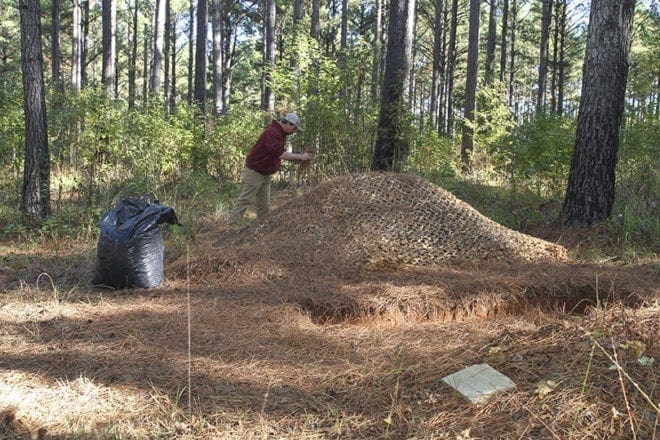
Neil Battles, an employee at Honey Creek Woodlands, Conyers, decorates a grave in the Pine Forest section of the natural burial grounds. On this particular day, a woman was being buried next to her husband, who died a year earlier. There were 12 natural burials at Honey Creek Woodlands in all of 2008. Today there have been over 1,200 burials. Photo By Michael Alexander
Whittaker last year stepped back to a part-time position. The families he served became “more friends than anything else,” he said. At his South Carolina home, he etches the sandstone markers families customize to be gravestones.
“We are people trying to help them through a difficult situation.”
Michael Wojcik, 60, helps touring visitors. He’ll also ensure services go smoothly. Wojcki commuted for years to Atlanta from Conyers for a job in the furniture industry, but feels in his heart his purpose is to minister to others. During the ebb and flow of a conversation on tours, he said he’ll mention how a sister is buried there.
“She is always part of my tour because of where she is in the pine forests section of the burial ground. It’s very easy to stop where she is and point out the fact that my own sister is there,” he said. “I pay tribute to her. I bring flowers to her when I can.”
His sister, Helen Thompson, died unexpectedly in June, 2018, during an operation. He had started at Honey Creek a week earlier. She and her husband hadn’t made any plans about funerals up to that point, but the family has deep roots in the Conyers Catholic community, so the link with the monastery pleased the family.
People learn more about the place as he shares his family’s story. He shepherds others through their loss.
“I hope they leave here thinking they have left their loved one not only in our hands, but God’s hands,” said Wojcik.
